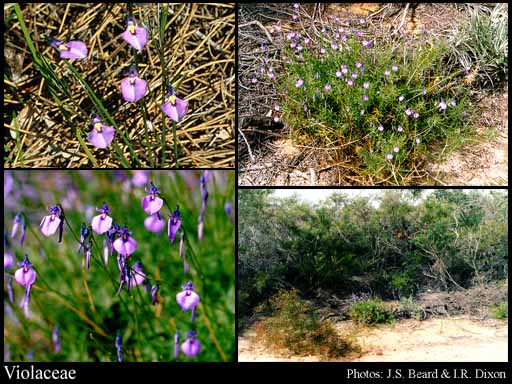- Reference
- Tab.Affin.Regni Veg. 57.2:57 (1802)
- Name Status
- Current

Scientific Description
Common name. Violet Family.
Habit and leaf form. Herbs, or herbaceous climbers, or shrubs, or lianas, or ‘arborescent’ (rarely). Plants the herbs with a basal concentration of leaves, or with neither basal nor terminal concentrations of leaves. Self supporting, or climbing. Mesophytic, or helophytic. Leaves alternate (usually), or opposite; spiral; petiolate, or subsessile, or petiolate and subsessile; non-sheathing; simple; epulvinate. Leaf blades entire (usually), or dissected; when dissected, pinnatifid; pinnately veined, or palmately veined; cross-venulate. Leaves with stipules. Stipules free of one another. Leaves without a persistent basal meristem. Domatia recorded (Rinorea); represented by pits (mostly), or hair tufts. Stem anatomy. Nodes tri-lacunar. Secondary thickening developing from a conventional cambial ring.
Reproductive type, pollination. Fertile flowers hermaphrodite. Unisexual flowers absent. Plants hermaphrodite (sometimes cleistogamous). Entomophilous.
Inflorescence and flower features. Flowers solitary (axillary), or aggregated in ‘inflorescences’; in cymes, or in racemes, or in heads, or in panicles. The terminal inflorescence unit cymose. Inflorescences usually racemes, panicles or heads. Flowers (bi-) bracteolate; fragrant, or odourless; somewhat irregular to very irregular (usually), or regular. The floral asymmetry involving the perianth, or involving the perianth and involving the androecium. Flowers 5 merous; cyclic; tetracyclic. Free hypanthium absent. Perianth with distinct calyx and corolla; 10; 2 -whorled; isomerous. Calyx 5; 1 -whorled; polysepalous (usually, more or less), or gamosepalous (at the base); imbricate, or open in bud; unequal but not bilabiate, or regular; basally appendaged (e.g. Viola), or neither appendaged nor spurred; persistent (often); with the median member posterior. Corolla 5; 1 -whorled; polypetalous; imbricate (usually, with descending aestivation), or contorted; unequal but not bilabiate (usually), or regular; spurred (the enlarged anterior member, often), or not spurred. Petals clawed, or sessile. Androecium 5. Androecial members free of the perianth; free of one another, or coherent; often 1 - adelphous (forming a cylinder round the ovary); 1 -whorled. Androecium exclusively of fertile stamens. Stamens 5; isomerous with the perianth; oppositisepalous; all alternating with the corolla members. Anthers cohering (often), or connivent, or separate from one another; adnate; introrse; tetrasporangiate; appendaged (the two anterior members often appendaged or spurred, the connective often prolonged), or unappendaged. Gynoecium (2–)3(–5) carpelled. The pistil 1 celled. Carpels reduced in number relative to the perianth (usually), or isomerous with the perianth. Gynoecium syncarpous; eu-syncarpous; superior. Ovary unilocular; 1 locular. The ‘odd’ carpel anterior. Gynoecium stylate, or non-stylate (Melicytus). Styles 1 (of various forms). Stigmas 1, or 3–5 (Melicytus); truncate (or appendiculate); dry type; papillate; Group III type. Placentation parietal. Ovules in the single cavity 1–100 (to ‘many’); arillate; anatropous.
Fruit and seed features. Fruit fleshy, or non-fleshy; dehiscent, or indehiscent; a capsule, or a berry, or a nut (rarely). Capsules loculicidal and valvular. Fruit when capsular, elastically dehiscent. Seeds endospermic. Endosperm oily. Seeds winged, or wingless. Cotyledons 2 (flat). Embryo chlorophyllous (8 species of Viola); straight. Seedling. Germination phanerocotylar.
Physiology, biochemistry. Aluminium accumulation demonstrated. Photosynthetic pathway: C3.
Geography, cytology, number of species. World distribution: cosmopolitan. X = 6–13, 17, 21, 23. 900 species.
Economic uses, etc. Over 120 species of Viola are grown as ornamentals.
Keys
Western Australian Genera and Families of Flowering Plants — an interactive key
T.D. Macfarlane, L. Watson, N.G. Marchant